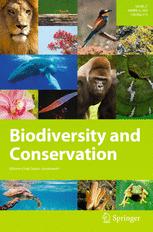Ver ítem
- xmlui.general.dspace_homeCentros Regionales y EEAsCentro Regional Patagonia SurEEA Santa CruzArtículos científicosxmlui.ArtifactBrowser.ItemViewer.trail
- Inicio
- Centros Regionales y EEAs
- Centro Regional Patagonia Sur
- EEA Santa Cruz
- Artículos científicos
- Ver ítem
Biodiversity potential of Nothofagus forests in Tierra del Fuego (Argentina): tool proposal for regional conservation planning
Resumen
It is difficult to map and quantify biodiversity at landscape level in areas with low data availability, despite demand from decision-makers. We propose a methodology to determine potential biodiversity pattern using habitat suitability maps of the understory plant species with highest cover and occurrence frequency in the three different forests types of Tierra del Fuego (Argentina). We used a database of vascular plants from 535 surveys from which we
[ver mas...]
It is difficult to map and quantify biodiversity at landscape level in areas with low data availability, despite demand from decision-makers. We propose a methodology to determine potential biodiversity pattern using habitat suitability maps of the understory plant species with highest cover and occurrence frequency in the three different forests types of Tierra del Fuego (Argentina). We used a database of vascular plants from 535 surveys from which we identified 35 indicative species. We explored more than 50 potential explanatory variables to develop habitat suitability maps of the indicative species, which were combined to develop a map of the potential biodiversity. Correlation among environmental, topographic and forest landscape variables were discussed, as well as the marginality and the specialization of the indicative species. We detected differences in the niches of the species prevailing in the three forest types. The developed map of potential biodiversity uncovered hotspots of biodiversity in the ecotone of Nothofagus pumilio and N. antarctica as well as in the wettest part of the mixed N. pumilio–N. betuloides forests. It allowed thus to identify forest areas with different conservation potential and can be readily used as a decision support system for conservation and management strategies at different scales including the identification of land-use conflicts (e.g. of biodiversity with timber production and livestock) and the development of a network of protected areas, which currently does not cover the forests of highest conservation value.
[Cerrar]

Autor
Martínez Pastur, Guillermo José;
Peri, Pablo Luis;
Soler Esteban, Rosina Matilde;
Schindler, Stefan;
Lencinas, María Vanessa;
Fuente
Biodiversity and Conservation 25 (10) : 1843–1862 (September 2016)
Fecha
2016-09
ISSN
0960-3115
1572-9710
1572-9710
Formato
pdf
Tipo de documento
artículo
Palabras Claves
Derechos de acceso
Restringido
 Excepto donde se diga explicitamente, este item se publica bajo la siguiente descripción: Creative Commons Attribution-NonCommercial-ShareAlike 2.5 Unported (CC BY-NC-SA 2.5)
Excepto donde se diga explicitamente, este item se publica bajo la siguiente descripción: Creative Commons Attribution-NonCommercial-ShareAlike 2.5 Unported (CC BY-NC-SA 2.5)

